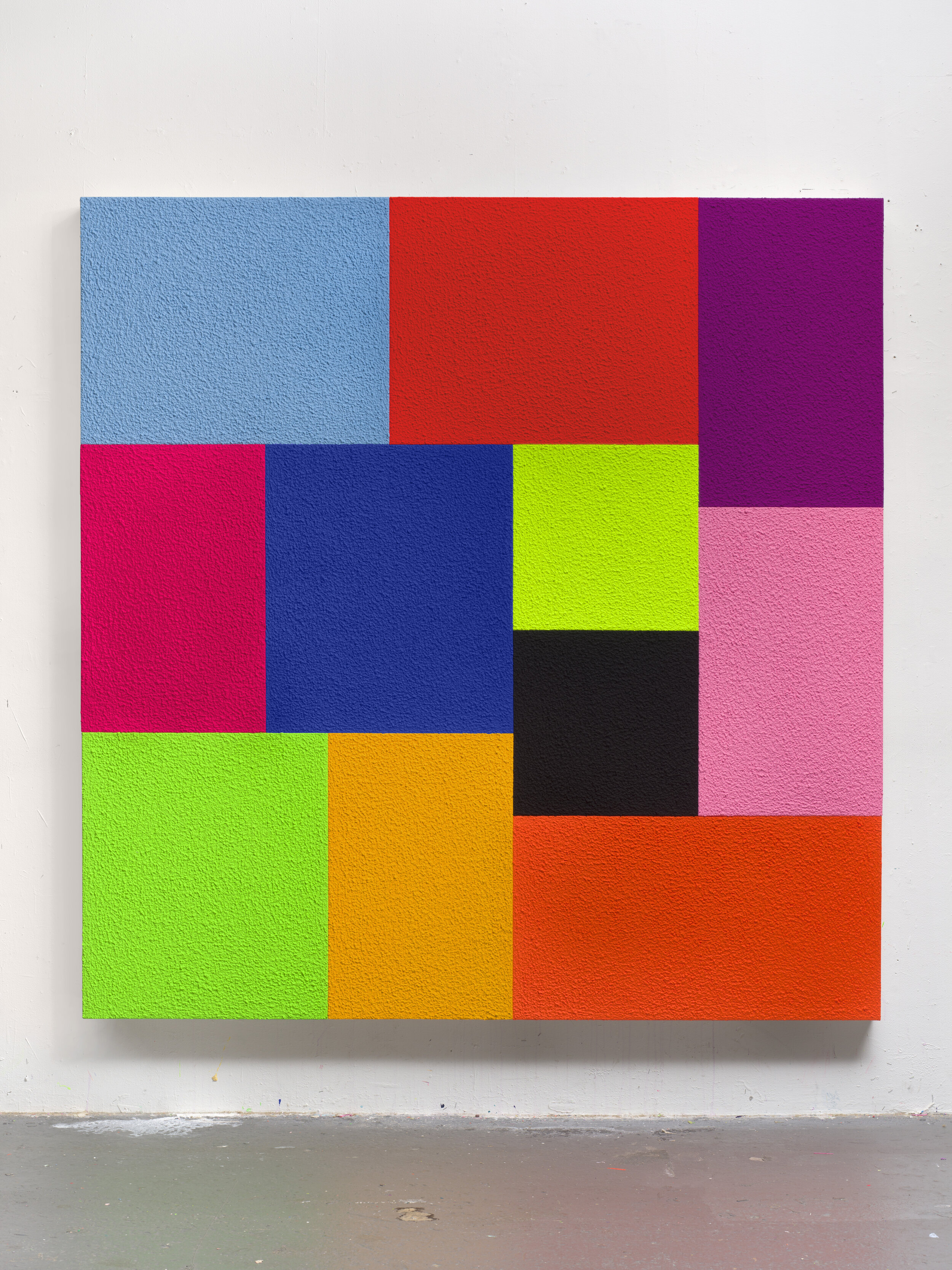peter halley
CELL GRIDS
Close, 2019. acrylic, fluorescent acrylic, Flashe, and Roll-a-Tex on joined canvases. Courtesy of Francois Bennahmias, Geneva
CELL GRIDS, Peter Halley’s first exhibition in Texas in more than fifteen years, presents a unique series of paintings made from 2015 to the present. CELL GRIDS showcases a surprising vein of Halley’s work, paintings in which one element of his distinctive iconography – his intensely colored rectilinear “cells” – is isolated and arranged into syncopated grids, bringing his work into dialogue with the structural grid of classic Modernism as represented in the work of Piet Mondrian, Agnes Martin, Andy Warhol and others.
Since the 1980s, Peter Halley’s paintings have blurred the distinction between geometric abstraction and representation. In Halley’s paintings, monochromatic squares become “prisons” and “cells,” while straight lines become the “conduits” connecting them.
The paintings on view in CELL GRIDS at Dallas Contemporary are a focused presentation of a new direction in Halley’s work developed over the last six years in which the artist has isolated a single element of his personal iconography, the intensely colored rectilinear “cells,” arranging them into large-scale syncopated grids.
Multiple canvases are bolted together into a tightly packed jigsaw puzzle devoid of atmosphere, while the paintings’ bright, luminous color combines with their rough tactile surfaces to create a palpable tension between attraction and repulsion.
Devoid of Halley’s usual practice of deploying his prisons, cells and conduits in a figure-ground space to create a recognizable narrative, the CELL GRIDS paintings tread a subtle line between purist Modernist abstraction and Post-Modern referentiality, creating yet another level of tension and ambiguity.
Shown together at Dallas Contemporary for the first time, this group of eighteen large-scale paintings extends Halley’s ongoing exploration of the language of painting. The exhibition offers a surprising new way of engaging with the artist’s work.
CELL GRIDS curated by Dallas Contemporary Executive Director Peter Doroshenko and will be accompanied by an exhibition catalogue.
Peter Halley: CELL GRIDS is made possible with lead support from Mark Giambrone, generous support from Marylin Lenox and the support of Debi De Muth + Peter Gottlieb, Kástra Elión, Molly + Jim Lazar, Dianne + Mark LaRoe, Lisa + John Runyon, Almine Rech (Paris - Brussels - London - New York - Shanghai), Baldwin Gallery, Aspen, Gary Tatintsian Gallery, Moscow, MARUANI MERCIER Gallery, Modern Art, London and Xippas Gallery.
about peter halley
Peter Halley (b. 1953) is an American artist who came to prominence as a central figure of the Neo-Conceptualist movement of the 1980s. His paintings employ the language of geometric abstraction to explore the organization of social space in the digital era. Halley’s lexicon includes only three elements: “prisons” and “cells”, connected by “conduits”, which are deployed in his paintings to explore the technologically determined space and pathways that regulate daily life. Using fluorescent color and Roll-a-Tex (a commercial paint additive that provides readymade texture), Halley embraces materials that are anti-naturalistic and commercially manufactured. Halley is known for his essays, written in the'80s and '90s, which explored the influence of burgeoning digital technology on art and culture. From 1996 to 2005, Halley published INDEX magazine, which included in-depth interviews with creative people in a variety of fields. He served as Director of Graduate Studies in Painting at the Yale University School of Art from 2002 to 2011. Peter Halley’s site-specific wall installation ANTESTERIA is currently on view at Museo Nivola in Sardinia. In 2023, the Musée d’Art Moderne Grand-Duc Jean (Mudam), Luxembourg, will present a survey of Peter Halley’s paintings from the 1980s. Recent solo exhibitions include installations at The Academy of Fine Arts Gallery, Venice (2019), the Lever House Art Collection, New York (2018), and the Schirn Kunsthalle, Frankfurt (2016). An exhibition of his paintings was held at the Santa Barbara Museum of Art, California (2015).

